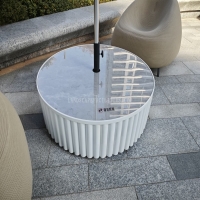Welcome to the website for landscape facilities products and knowledge.
How does the table’s design support or hinder the use of physical or digital whiteboarding tools?
The integration of whiteboarding into collaborative sessions has become fundamental to modern workflows, whether through traditional physical whiteboards or advanced digital platforms. However, the design of the table around which these activities occur plays a surprisingly pivotal role in either facilitating or frustrating the process. A well-considered table design can dramatically enhance the utility of both physical and digital whiteboarding tools, while a poor design can render them nearly ineffective.
For physical whiteboarding, the table's form is directly tied to its function. A table with a low-profile base or a cantilevered design allows users to roll a physical whiteboard directly up to the edge, creating a seamless transition between the table surface and the board. This eliminates the physical barrier that can disrupt the flow of ideas and allows all participants an unobstructed view. Conversely, a table with bulky legs or a central support pedestal acts as a literal blockade, forcing users to awkwardly reach over it or stand up repeatedly to interact with the board, thereby breaking concentration and collaborative momentum. The table's surface material also matters; a smooth, hard finish is ideal for placing smaller, portable whiteboards without wobbling, whereas a soft or textured surface can be unstable.
When it comes to digital whiteboarding, the table's design shifts from enabling physical access to integrating technology. The most supportive tables are those engineered with technology in mind. This includes built-in power outlets and USB ports at the table's edge or within a dedicated raceway, preventing the need for unsightly and hazardous cable trails across the floor to power laptops or the interactive display itself. Furthermore, tables designed for use with large interactive displays or smartboards often feature reinforced tops and stable, wobble-free legs to safely support the heavy, expensive equipment. Cable management grommets are crucial for keeping wires from the display, computers, and other peripherals organized and out of sight, maintaining a clean aesthetic that fosters focus. A poorly designed table lacking these features turns a high-tech digital whiteboarding session into a logistical nightmare of extension cords and cluttered cables, distracting from the creative task at hand.
The shape and size of the table further influence the collaborative dynamic. Round or oval tables promote equality and easier eye contact among participants, which is beneficial for inclusive brainstorming with both physical and digital tools. Rectangular tables, while traditional, can create a "head" position that might unintentionally hierarchize the session. For digital whiteboarding, the table's size must be proportionate to the display; a table that is too small forces participants to sit too close to a large screen, while a table that is too large creates a physical disconnect from a smaller display, making it difficult for those at the far end to see or interact with the digital canvas.
Ultimately, the table is not merely a piece of furniture but a critical component of the collaborative ecosystem. A design that considers sightlines, legroom, technology integration, and proximity to the whiteboarding surface—be it physical or digital—actively supports fluid ideation and teamwork. It transforms the whiteboard from a standalone tool into an integrated part of the workspace. On the other hand, a table chosen without regard for these functions becomes a persistent hindrance, creating friction at every stage of the creative process. Therefore, when designing or selecting a table for a collaborative space, its relationship to the primary ideation tools must be a primary consideration, not an afterthought.
Related search:

Recommendation
Round metal tube border design table with tempered glass or granite countertop on the top.